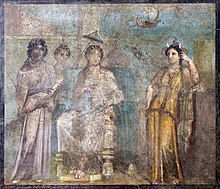Africa (goddess)



Goddess Africa, also known as Dea Africa, was the personification of Africa by the Romans in the early centuries of the common era.[1][2] She was one of the fertility and abundance deities to some. Her iconography typically included an elephant-mask head dress, a cornucopia, a military standard, and a lion.[3]
To the Romans "Africa" was only Tunisia, which they had conquered, and the goddess/personification was not given African characteristics; she was possibly thought of as Berber, but this cannot be judged in the great majority of representations. This changed after she was revived in the Renaissance, by now clearly only the personification of Africa with no divine pretensions.[citation needed]
Roman use[edit]
She is portrayed on some coins, carved stones, and mosaics in Roman Africa. A mosaic representing Roman Africa is found in the El Djem museum of Tunisia.[1][4][5] A sanctuary found in Timgad (Thamugadi in Berber) features goddess Africa's iconography.[6]
She was one of a number of "province personifications" such as Britannia, Hispania, Macedonia and a number of Greek-speaking provinces. Africa was one of the earliest to appear, and may have originated with the publicity around Pompey the Great's African triumph in 80 BC; some coins with both Pompey and Africa shown survive.[7]

The elephant headdress is seen first on coins depicting Alexander the Great, commemorating his invasion of India, including the (possibly fake) "Porus medallions" issued during his lifetime and the coinage of Ptolemy I of Egypt issued from 319 to 294 BC.[8] It may have had resonances with Pharaonic ideology.[8] The image was later adopted on coinage of Agathocles of Syracuse minted around 304 BC, following his African Expedition.[9] Subsequently it is seen on coinage of King Ibaras of Numidia, a kingdom that Pompey defeated in 1st century BCE, so very likely picked up from there by Pompey's image-makers.[7]
Goddess[edit]
To the Romans the distinction between goddesses who received worship and personification figures understood to be literary and iconographic conveniences was very elastic, and Africa seems to have been on the boundary between the two. She was certainly not a major deity, but may have received worship at times.
Pliny the Elder, in his book Natural History, wrote "in Africa nemo destinat aliquid nisi praefatus Africam", which scholars translate as "no one in Africa does anything without first calling on Africa".[10] This has been the literary proof of her existence and importance, in some cases interpreted as a proof for a North African goddess-centric cult. Other writers have also interpreted the female personification of Africa to be a "Dea" or goddess.[11]
Maritz, however, has questioned whether personified Africa was ever a "Dea" or goddess to Romans, or anywhere else. The iconographic images of "Dea Africa" with elephant scalp head dress was just a Roman icon for Africa, states Maritz. This is likely because neither Pliny nor any writer thereafter ever described her as "Dea", nor is there an epigraphical inscription stating "Dea Africa". In contrast, other Roman goddesses carry the prefix "Dea" in texts and inscriptions. Romans already had their own goddesses of fertility and abundance, states Maritz, and there was no need for a competing goddess with the same role.[12]
Renaissance revival[edit]
In the Renaissance Africa was revived, along with other personifications, and was, by the 17th century, usually given a dark complexion, curly hair and a broad nose, in addition to her Roman attributes.[13] She was a necessary part of images of the Four Continents, which were popular in several media.
See also[edit]
References[edit]
- ^ a b c Gifty Ako-Adounvo (1999), Studies in the Iconography of Blacks in Roman Art, Ph.D. Thesis awarded by McMaster University, Thesis Advisor: Katherine Dunbabin, page 82
- ^ Christine Hamdoune (2008), La dea Africa et le culte impérial[permanent dead link], Études d'antiquités africaines, Volume 1, Numéro 1, pages 151-161
- ^ Paul Lachlan MacKendrick (2000). The North African Stones Speak. University of North Carolina Press. p. 236. ISBN 978-0-8078-4942-2.
- ^ Parrish, David (2015). "The mosaics of El Jem". Journal of Roman Archaeology. 12: 777–781. doi:10.1017/S1047759400018663. ISSN 1047-7594.
- ^ Robert A. Wild (1981). Water in the Cultic Worship of Isis and Sarapis. Brill Archive. pp. 186–187. ISBN 90-04-06331-5.
- ^ Aomar Akerraz; Moustapha Khanoussi; Attilio Mastino (2006). L' Africa romana: Atti del XVI convegno di studio, Rabat, 15-19 dicembre 2004. dell'Universita degli Studi di Sassari. pp. 1423, 1448. ISBN 978-88-430-3990-6.
- ^ a b Ostenberg, Ida (2009). Staging the World: Spoils, Captives, and Representations in the Roman Triumphal Procession. Oxford University Press. pp. 222–223 with footnote 138. ISBN 978-0-19-921597-3.
- ^ a b Lorber, Catherine (2018). Coins of the Ptolemaic Empire. New York: American Numismatic Society. p. 46-59.
- ^ de Lisle, Christopher (2021). Agathokles of Syracuse : Sicilian Tyrant and Hellenistic King (First ed.). Oxford: Oxford University Press. pp. 128–130. ISBN 9780191894343.
- ^ J. A. Maritz (2006), "Dea Africa: Examining the Evidence", Scholia: Studies in Classical Antiquity, Volume 15, page 102
- ^ Levy, Harry L. (1958). "Themes of Encomium and Invective in Claudian". Transactions and Proceedings of the American Philological Association. 89: 336–347. doi:10.2307/283685. ISSN 0065-9711. JSTOR 283685.
- ^ J. A. Maritz (2006), "Dea Africa: Examining the Evidence", Scholia: Studies in Classical Antiquity, Volume 15, pages 102-121
- ^ Spicer, Joaneath (2016). "The Personification of Africa with an Elephant-head Crest in Cesare Ripa's Iconologia". Personification. Brill Academic. pp. 675–715. doi:10.1163/9789004310438_026. ISBN 9789004310438.
Further reading[edit]
- Paul Corbier, Marc Griesheimer, L’Afrique romaine 146 av. J.-C.- 439 ap. J.-C. (Ellipses, Paris, 2005)


 French
French Deutsch
Deutsch